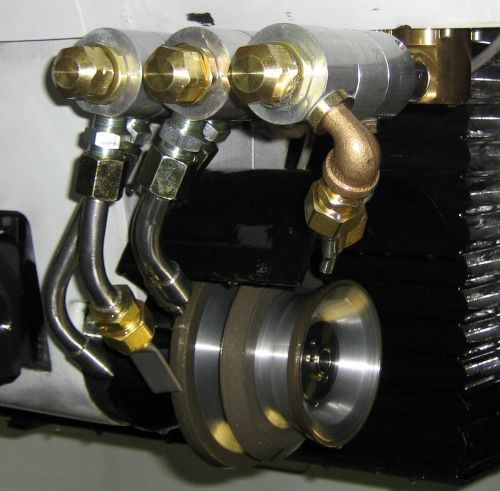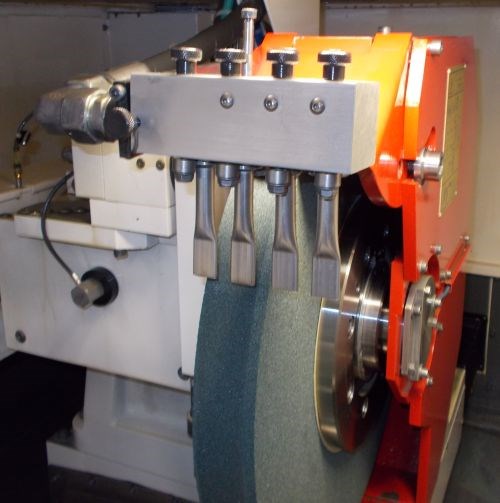Nozzles are often used to supply coolant during grinding or machining operations to control workpiece temperature, keep the grinding wheel or tool clean and open for chip flow, enable extreme pressure additives in the coolant to do their job, and flush chips away from the cutting area. Popular configurations include rigid, bent metal tubes and conformable plastic versions with many joints. Plastic nozzles are designed for low pressure (approximately 30 psi) and can stray out of position at higher pressure. They are easy to aim, but need to be placed close to the workpiece because they generate wide, dispersed jets that entrain air into the coolant stream. Rigid metal tubes are stiffer, but they also deliver dispersed coolant jets. Re-aiming them requires frequent bending that ultimately leads to fracture. Plus, their close proximity to the tool can result in damaged nozzle tips and reduced jet quality.
During the past 20 years, I have demonstrated that coherent-jet nozzles are more effective than plastic and rigid tube nozzles for coolant delivery. Their internal nozzle geometry creates a tight, coherent jet when the coolant exits. This is especially important for grinding, because most of the heat goes into the part, not away with the chips.
Grinding wheel speeds of 6,000 sfpm or higher generate a boundary layer of air that stops low-pressure coolant from wetting the wheel surface. Conversely, coherent jets’ higher impact energy and their ability to match the wheel speed remove that boundary layer and enable the wheel to carry the coolant directly into the grinding zone. The concentrated stream is also easier to aim into critical cutting areas even at pressures as high as 600 psi. (Miniature lasers are available that fit onto the tip of a nozzle to predict the aim of the jet.) In addition, the flow rate of coolant into the cutting zone is more defined than with a dispersed jet. For grinding, an established flow rate model to effectively cool the process is 2 gpm per spindle horsepower. Therefore, a 5-hp cycle requires a 10-gpm coolant flow rate. This stream has to be correctly aimed for effective grinding at this flow rate.
Coherent-jet nozzles also offer a high degree of adjustability and stiffness once aimed. Nozzles can be fitted with swivel joints that lock after aiming. Individual nozzles are fitted with threaded caps and linear manifolds (with an array of two or more nozzles) are fitted with knurled knobs. Round and flat nozzle tubes (nozzles attached to tubes) can be bent very close to the tip of the nozzle using special tube benders. In addition, nozzle tubes can be fixed to a manifold or pipe fitting using special collets to enable axial and rotary adjustment when aiming the jet. This differs from conventional compression fittings that bite permanently onto a tube. Such inherent versatility enables very complex wheels or tool profiles to be fully covered by coolant.
Benefits of improved coolant delivery using coherent jet technology include:
• Reduced tool wear. Consistent, direct cooling exploits the lubricity of the coolant, reduces grinding wheel dressing frequency and enables harder grade wheels to be used without the concern of workpiece thermal damage.
• Better workpiece surface integrity. There is no quenching of a hot workpiece before the next wheel pass when coolant delivery is consistent.
• Reduced pumping energy. Direct cooling reduces the total flow rate supplied to the machine, decreasing the amount of pumping energy that’s needed.
• Reduced foam and filter media indexing. A more effective overall grinding process is possible with greater nozzle efficiency and a lower flow rate.
• Unattended operation. More rigid nozzles prevent jets from moving out of position so that machines can continue to run safely while an operator is away.
• More consistent spindle power. Less loading of the wheel (or tool) with chips produced in previous revolutions yields more stable spindle power and better part geometry.
• Less risk of nozzle damage. Grinding processes are inherently more robust when nozzles can be located farther from a wheel or tool.
About the author: Dr. John Webster is the president of
Cool-Grind Technologies located in Ashford, Connecticut.







.jpg;maxWidth=300;quality=90)
.jpg;maxWidth=300;quality=90)
















